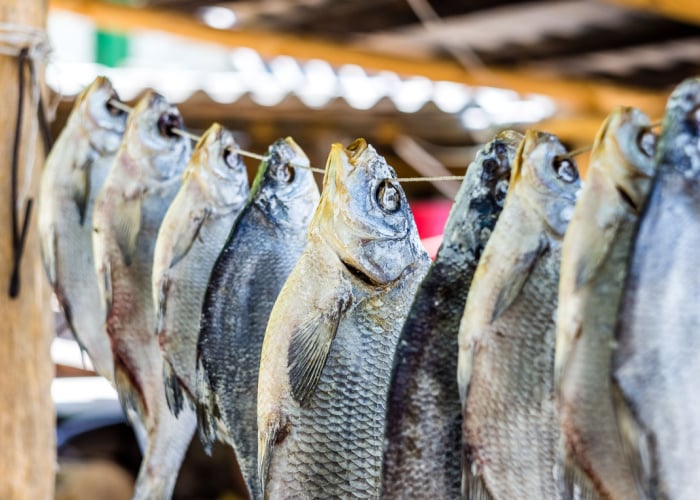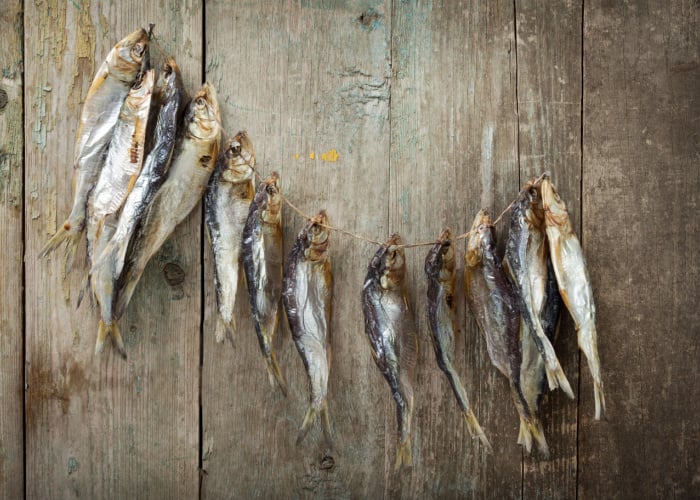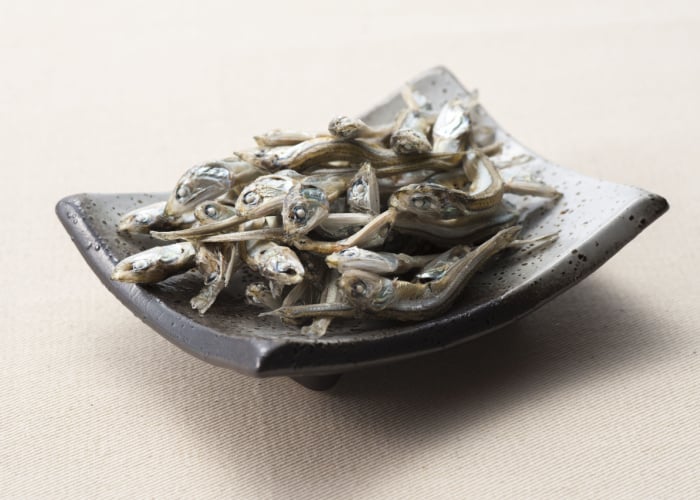Table of Contents
Light, crispy, and full of umami.
If you love fish, then you will love dried fish!
Trust me; we Asians love to feast on this wonderful delicacy.
But I’ve been thinking whether I can feed it to my dog.
After all, they can eat fish. Surely, they can also eat a dried form of it, right?
Should we let our dogs eat dried fish?
In this blog, we’ll answer the question, “Can dogs eat dried fish?”
Let’s also discuss its potential health benefits and risks for our pets.
I’m excited to share gold-nugget information about the effects of feeding dried fish to dogs!
And if you are, too, then let’s start!

Can Dogs Eat Dried Fish?
The short and simple answer to this question is yes, they can, but with caution!
Your dog can eat fish. Naturally, they can eat dried fish, too.
After all, they are just dehydrated using a thorough drying process.
So, as long as the fish is not poisonous, the dogs can still eat it even when it’s dried.
As a matter of fact, dried foods retain nutrients better than fresh ones, according to studies.
This means dried fish will have more nutrients than fresh fish per serving.

Is Dried Fish Good for Dogs?
Some foods are edible but not good for dogs.
But luckily, dried fish are nutritious treats for Fido!
Here is the nutritional value of dried fish per serving size of one ounce.
- Protein: 36% of the Daily Value (DV)
- Vitamin B12: 118% of the DV
- Vitamin B6: 14% of the DV
- Vitamin B3: 13% of the DV
- Vitamin D: 6% of the DV
- Vitamin E: 5% of the DV
- Selenium: 76% of the DV
- Phosphorous: 22% of the DV
- Potassium: 9% of the DV

Benefits of Dried Fish for Dogs
As shown above, dried fish is jam-packed with essential daily nutrients to improve dog health.
But exactly how do these nutrients translate to health benefits that your dog enjoys?
Let’s talk about it more below!
1. Great Source of Protein
Dried fish is an excellent source of protein for dogs.
And protein is arguably one of the most important nutrients in a dog’s meal.
Your dog digests and breaks down proteins into amino acids.
Dogs need amino acids because they are the building blocks of various proteins in their body.
Justin Shmalberg, DVM, from Today’s Veterinary Practices, explains:
Body protein is composed of 20 different amino acids, which are linked together in long chains with peptide bonds. Proteins display complex structures, which serve a number of physiologic and biochemical processes.
Some of the processes that Dr. Shmalberg refers to are:
- Cell signaling
- Muscle contraction
- Oxygen and nutrient transport in the blood, plus oncotic support
- And other critical functions in the dog’s body that are vital to its survival
Some of the many body components in your dog that amino acids help build are:
- Muscles
- Skin
- Fur
- Bones
- Nails
- Connective Tissues
- Hormones
- Digestive Enzymes
- Blood Component
- Immune System
And with dried fish meeting 36% of your dog’s daily protein needs, you may want to start feeding it to your dog now.
2. Anti-Inflammatory Properties
Itchy, inflamed skin? Swelling body parts in dogs? Dried fish might have a solution for that!
The U.S. Department of Agriculture recorded a lot of fish species that are rich in omega-3 fatty acids.
Specifically, these fishes are rich in Eicosapentaenoic Acid (EPA) and Docosahexaenoic Acid (DHA).
These specific types of fatty acids are known to reduce the swelling of your dog.
But how? How do DHA and EPA reduce or prevent inflammation?
Well, these two fatty acids limit the inflammation mediators inside the body.
Inflammation mediators are protein-like substance inside the body that triggers inflammation.
That means limiting these compounds would also reduce the swelling.
3. Fights Free Radicals
When we talk about our dog’s health, we often come across the terms “free radicals” and “antioxidants.”
So, let’s talk about these concepts first, and then I’ll share how feeding dried fish to dogs is related to them.
Free radicals are unstable and highly reactive compounds inside your dog’s system.
They can cause oxidative stress to your dog, damaging your dog’s cells, tissues, or organs at the molecular level.
This can cause chronic illnesses in your dog on a large scale.
And that’s why feeding your dog with foods rich in antioxidants—like dried fish—is important.
Antioxidants work by neutralizing the instability of the free radicals in your dogs.
They also repair cells that the oxidative stress damaged.
Giving your dog dried fish supplies it with antioxidants that combat the effects of free radicals.
Here are some of the known antioxidants present in dried fish:
- Omega 3 fatty acids
- Selenium
- Vitamin E
- Trace amounts of Vitamin C
4. Improve Brain Function
Did you know that feeding dried fish to dogs helps improve their brain?
This is because dried fish is rich in a certain omega-3 fatty acid called DHA.
DHA also plays a major role in regulating a lot of the brain’s neurological function for most mammals.
It helps:
- Develop neurons and brain tissues
- Reduce inflammation in the brain
- Develop neural links and structures
Well, that’s nice and all, but how does that translate into my dog’s well-being?
A healthy brain means your dog will have great cognitive skills.
This is important for your dog’s problem-solving abilities, response to commands, reaction time skills, and memory.
Additionally, DHA slows down the brain’s degeneration, lessening the risk of mental issues for your dog.
With these evidence-backed facts, you’ll rest easy knowing that you’ll be doing your dog a great favor the next time your dog eats dried fish.
5. Improve Blood Circulation
The health benefits don’t stop with just the brain.
Eating dried fish also improves your dog’s cardiovascular system!
The Journal of Clinical Investigation presents a finding about how Omega-3 reduces the bad fats in the body.
In one of their issues, they found that Omega-3 accumulates in the bile to reduce bad cholesterol production in the liver.
They also discovered that Omega-3 lowers the absorption of fats in the intestine.
It helps lower the bad cholesterol and triglyceride levels inside your dog’s system.
Feeding your dog with dried fish also supplies them with potassium.
This trace mineral is known to promote good heart muscle contraction.
All these benefits contribute to making your dog’s cardiovascular system healthy.
6. Rich in Trace Minerals
We've already discussed potassium above as a trace mineral in dried fish.
But that's not all!
They also contain:
- Potassium
- Phosphorus
- Magnesium
- Calcium
- Iron
- Manganese
- Selenium
- Zinc
Since your dog’s body cannot produce many of these essential nutrients, they need to get it elsewhere.
And that ‘elsewhere' could be dried fish!

Risks of Eating Dried Fish to Dogs
Yes, dried fish give a lot of health benefits when fed to dogs, but it can also pose potential drawbacks for them.
And that shouldn’t come as a shocker.
Even water is harmful to dogs when drunk at an outrageous amount!
Which brings us back to dried fish for dogs. Can dried fish be bad for dogs, too?
Unfortunately, dried fish can be bad for your dog, too.
This happens either because the fish is high in sodium and mercury or because of fish bone ingestion.
Let’s find out more about these risks below!
High Sodium Content
Many dried fish in the market—especially in Asian markets—often use salt in their drying process.
Salt draws out the moisture in the fish’s flesh, preparing it for sun-drying.
That’s why most dried fish are high in sodium content.
And any excess amounts of salt intake can lead to salt poisoning for your poor dog.
Symptoms of salt toxicosis, as explained by Larry Thompson, DVM, former Senior Research and Vet Toxicologist at Nestle Purina Petcare, include:
- depression
- weakness
- ataxia
- muscle tremors
- gastroenteritis
- seizure-like activity
When it comes to treatment, Dr. Thompson said:
Treatment approach is to evaluate the patient's hydration and electrolyte status and slowly return the animal to normal water and electrolyte balance over several days.
Some fish drying techniques vets recommend as alternatives to salty-dried fish are freeze-drying or dry aging.
A lot of healthy dog treats are also dehydrated using these processes.
So, if you can get your hands on freeze-dried fish or a dry-aged one, your fish-eating Fido will probably thank you for it!
Fishes with High Mercury Content
The Food and Drug Administration deemed that nearly all fish contain traces of mercury.
And some fish in the market have more mercury than other fish types!
Try to avoid feeding your dog the following fish as they may contain high levels of mercury:
- Bluefish
- Groper
- Marlin
- Chilean Sea Bass
- Orange Roughy
- Yellowfin Tuna
- Ahi Tuna
- Big Eye Tuna
If you want to feed your dog with dried fish, stick with the types of fish that are low in accumulated mercury.
Some of these fish are:
- Salmon
- Sardine
- Anchovies
- Tilapia
- Freshwater Trout
- Catfish
- Flounder
Fish Bones
Fish bones are immediately a hazard when you feed your dog with fish.
Because they are small and sharp, they can easily swallow these, which can become a choking hazard.
So do your dog a favor and debone the fish before feeding it to them.

How to Feed Dried Fish to Dogs
When it comes to feeding dried fish to dogs, you want to give it in small amounts.
For example, if it's dried sardines, you can give him one or three small pieces daily.
Ideally, you don’t want to feed him dried sardines in one go. Just give your pet a piece of every meal as a side dish.
But Dan, isn't three fish a day too few?
Trust me; a little dried fish goes a long way in supplying your dog with its much-needed Omega 3 Fatty Acids!
Besides, it's better to be cautious instead of going overboard, as you might risk overdosing your dog with sodium.
You can consult your trusted vets for more advice on feeding your dog dried fish.
Can Dogs Eat Dried Fish: Final Thoughts
To sum it up, yes, your dog can eat dried fish.
Dogs can eat fish fresh; they can also consume it when it is dried!
It packs a lot of nutrients that you don’t get much from other protein-based foods like pork or beef.
Dogs can also get the most essential omega-3 fatty acids in fish.
Just don't overfeed them!
Since your typical dried fish are salty, too much of it can lead to serious salt poisoning in dogs.
That’s why you should only feed dried fish to your dog in small quantities.
Don’t go overboard with the amount to maximize the benefits while minimizing the risks involved!
But wait!
Now that we know dogs can eat dried fish, what about raw fish?
Feel free to check out the articles below to learn more about feeding dogs with fish.













